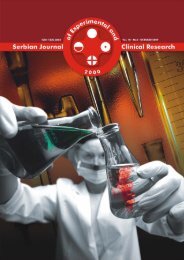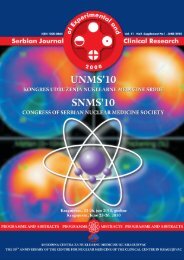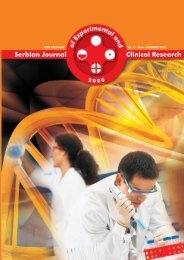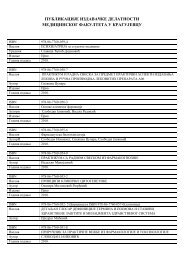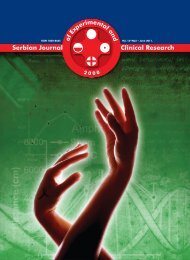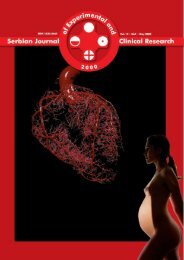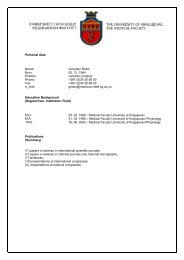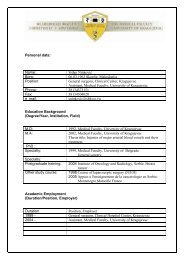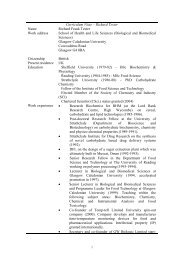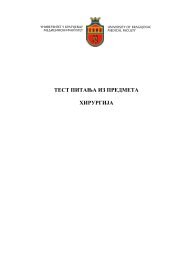neurotoxicity and mechanisms of induced hyperexcitability
neurotoxicity and mechanisms of induced hyperexcitability
neurotoxicity and mechanisms of induced hyperexcitability
You also want an ePaper? Increase the reach of your titles
YUMPU automatically turns print PDFs into web optimized ePapers that Google loves.
INTRODUCTIONSince 1880, when von Mering <strong>and</strong> Minkowski removedthe pancreas from a dog displaying symptoms <strong>of</strong> diabetesmellitus (1), many experiments have been conducted onmice, rats, rabbits, <strong>and</strong> dogs, which were all used as experimentalmodels for this disease.The rodents (mice <strong>and</strong> rats) are most frequently usedin laboratory research <strong>of</strong> type 1 <strong>and</strong> type 2 diabetes becausethey are biologically <strong>and</strong> genetically similar to people,their reproductive potential is high, their life spanis short, <strong>and</strong> they are cheap <strong>and</strong> easy to h<strong>and</strong>le (1). Themain drawback <strong>of</strong> these models is that sometimes theyare unable to successfully simulate pathological processesoccurring in humans; in those situations, the use <strong>of</strong> cats,dogs, pigs or primates is justifiable.Models <strong>of</strong> experimental diabetes are:1. <strong>induced</strong> (experimental)2. spontaneous (genetically <strong>induced</strong>) or3. transgenic <strong>and</strong> knock-out models (resulting from geneticengineering).Hyperglycemia is <strong>induced</strong> by:1. surgical method (partial or total pancreatectomy)2. non-surgical method (using a diabetogenic toxin in experimentalanimals) (Table 1) (2).MATERIALS AND METHODSWe searched the electronic databases Medline, Highwire,<strong>and</strong> Hinari. Selected papers, both original <strong>and</strong> review,have been summarized <strong>and</strong> cited with regard to theirscientific relevance for this research field.EXPERIMENTAL MODELS OFTYPE 1 DIABETES MELLITUSA) Induced modelsMultiple low-dose streptozotocin-<strong>induced</strong> diabetesStreptozotocin (STZ) is a derivative <strong>of</strong> nitrosoureathat has been isolated from Streptomyces achromogenes.It is a strong alkylating agent that affects glucose trans-ToxinDiabetogenic effectStreptozotocin Hyperglycemia, glucose intoleranceAlloxanHyperglycemia, glucose intoleranceChlorozotocin Hyperglycemia, glucose intoleranceDithizone Hyperglycemia, glucose intoleranceVacorHyperglycemiaOxineHyperglycemiaMethylnitrosurea Glucose intoleranceCyproheptadine Glucose intoleranceTable 1. Toxins with diabetogenic effectport (the role <strong>of</strong> glucokinase) <strong>and</strong> induces numerous lesionsin the beta-cell DNA chain (3-5). It can selectivelybind to glucose-transport protein 2 (GLUT2), which ispredominantly expressed on the membranes <strong>of</strong> pancreaticbeta-cells (3).Toxicity <strong>of</strong> the streptozotocin on beta-cells is complex<strong>and</strong> includes genetic <strong>and</strong> non-genetic <strong>mechanisms</strong> (6). Nitricoxide (NO) <strong>and</strong> other free radicals influenced by streptozotocinresult in spontaneous lesions <strong>of</strong> the DNA chain(7). Damaged DNA chains activate poly-(ADP-ribose)polymerase (PARP) as a reparatory mechanism, which incase <strong>of</strong> over-activation may have proapoptotic effects (8).PARP knockout mice were shown to be resistant for streptozotocin-<strong>induced</strong>diabetes (8).In addition, the toxicity <strong>of</strong> streptozotocin is associatedwith a drastic decrease <strong>of</strong> insulin reserves within beta cells,resulting from the fast catabolism <strong>of</strong> nicotinamide-adenine-dinucleotide+(NAD+), a substrate for PARP activation(9). Decrease <strong>of</strong> NAD+ <strong>and</strong> ATP+ provokes significantdepletion <strong>of</strong> insulin secretion as well as other basic processesinside the cell. While excessive activation <strong>of</strong> PARPrepresents a proapoptotic stimulus, the reduction <strong>of</strong> necessarycell energy results in cellular necrotic death.A single high dose <strong>of</strong> streptozotocin provokes diabetesin rodents, possibly as a result <strong>of</strong> the direct toxic effect.Multiple low-dose streptozotocin-<strong>induced</strong> diabetes (whenstreptozotocin is administered in lower doses (40 mg/kg)during five consecutive days) is an experimental model<strong>of</strong> type 1 diabetes <strong>and</strong> immune-mediated insulitis <strong>and</strong> iswidely used for studying the immunological background<strong>of</strong> this disease (10).Partial pancreatectomyThe partially pancreatectomised rat was one <strong>of</strong> the firstexperimental models <strong>of</strong> diabetes (11). The surgical removal<strong>of</strong> 90% <strong>of</strong> the pancreatic tissue resulted in a slow development<strong>of</strong> hyperglycemia over the course <strong>of</strong> 12 weeks to 20months (12). The period <strong>of</strong> post-surgical euglycemia is followedby the development <strong>of</strong> chronic hyperglycemia as aconsequence <strong>of</strong> a further failure <strong>of</strong> the remaining beta cells.The first stage <strong>of</strong> disease refers to glucose intolerancefollowed by a compensatory hyper-function <strong>of</strong> beta-cells,the exhaustion <strong>of</strong> the remaining beta cells <strong>and</strong> their furtherbreakdown 14 weeks after surgery (12). Altered beta cellgene expression is associated with a decreased production<strong>of</strong> islet amylin polypeptide (IAPP), transcription factors,ionic canals <strong>and</strong> pumps, including GLUT2, glucokinase,mitochondrial glycerophosphate dehydrogenase (mGPD)<strong>and</strong> pyruvate carboxylase (13). A reduction <strong>of</strong> insulin secretionfollows even in conditions <strong>of</strong> high concentrations<strong>of</strong> glucose <strong>and</strong> even after application <strong>of</strong> insulin secretagogues(14).Histopathological findings demonstrate hypertrophy<strong>and</strong> fibrosis <strong>of</strong> pancreatic islets related to the level <strong>of</strong> hyperglycemia(13). Insulitis, demonstrated as the infiltration<strong>of</strong> inflammatory cells, may be depressed, thus slowingdown the process <strong>of</strong> cell degeneration (15).30



